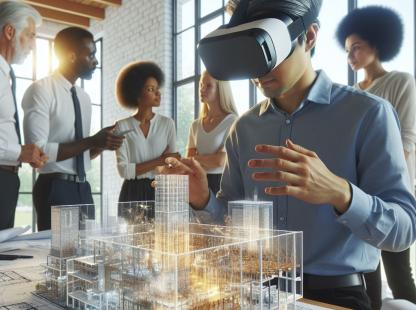
Uses of Extended Reality in Engineering and Architecture
Did you know that Extended Reality (XR) has many uses in Engineering and Architecture?
Engineering and Architecture are two of the many disciplines that benefit from immersion and interactivity inherent to extended reality (XR). Engineers and architects cannot only explore the models in virtual reality (VR), but VR apps of today make it possible to view them on a real-world scale and tour the models. It also allows engineers and architects to work collaboratively, annotate objects, and detect and solve design problems in virtual reality. And because it is virtual, cost savings can be seen since VR reduces the need for physical mockups (Marcolueg, 2024).
The use of VR in biochemical engineering is transforming the way we visualize complex biochemical structures. Some universities refer to something called “immersive engineering” which allows students to understand chemical engineering interactively. For example, students can virtually alter the pressure and temperature conditions to understand the behavior of substances in extreme conditions in a much better way (IXRLabs, n.d.). Of course, whenever there are chemicals, lab professionals must be trained but without putting trainees at risk. This can be achieved thanks to VR. A splendid example of such is OneLab VR by The Centers for Disease Control and Prevention (CDC). It is a virtual reality environment designed for clinical and public health laboratory training. The virtual reality environment includes a 50,000-square-foot virtual facility with various lab environments and over 100 pieces of custom-built equipment, allowing live and interactive training sessions.
BASF is the world’s largest chemical company. The company has implemented safety training in VR for its employees. BASF uses VR to simulate dangerous situations in a controlled, virtual environment. Because of that, employees can practice responding to emergencies such as chemical spills or fires without putting themselves at risk and, thus, avoiding potential fatalities. The VR training includes interactive content where employees can engage with virtual equipment and scenarios. This hands-on approach helps in better understanding and retention of safety protocols. Initially launched in Belgium, BASF is expanding this VR training program to its facilities in Germany and the USA. This widespread adoption underscores the effectiveness and scalability of VR training (Microsoft Copilot, 2024).
We can also see a proliferation of VR use in mechanical engineering. Often, 3D models of heavy equipment which normally require a lot of money to prototype, perform technical reviews, simulate, and manipulate, can be done so for less cost in virtual reality. In VR, simulations of the behavior of machines and mechanical systems can be experienced. VR also allows engineers to test and optimize designs before building physical prototypes - a huge benefit businesswise (Kumar et al., 2021).
The list of disciplines that take advantage of XR – whether VR, AR, or MR – is quite long to list here. If you are an instructor or an academic leader and would like to discuss how to best integrate extended reality (XR) into your curriculum, please reach out to the Office of Digital Learning.
If you are an instructor or an academic leader and would like to discuss how to best integrate extended reality (XR) into your curriculum, please reach out to the Office of Digital Learning.
- Marcolueg. (2024, July 17). Virtual Reality in Architecture. Virtual Arena. https://virtualarena.tech/en/virtual-reality-in-architecture/
- IXRLabs. (n.d.). How Virtual Reality is Revolutionizing Chemical Engineering. IXRLABS. https://www.ixrlabs.com/blog/how-virtual-reality-is-revolutionizing-chem...
- Kumar, V. V., Carberry, D., Beenfeldt, C., Andersson, M. P., Mansouri, S. S., & Gallucci, F. (2021). Virtual reality in chemical and biochemical engineering education and training. Education for Chemical Engineers, 36, 143–153. https://doi.org/10.1016/j.ece.2021.05.002
- Microsoft. (2024). Copilot (Version 4.0) [AI language model]. Microsoft. Available from https://www.microsoft.com